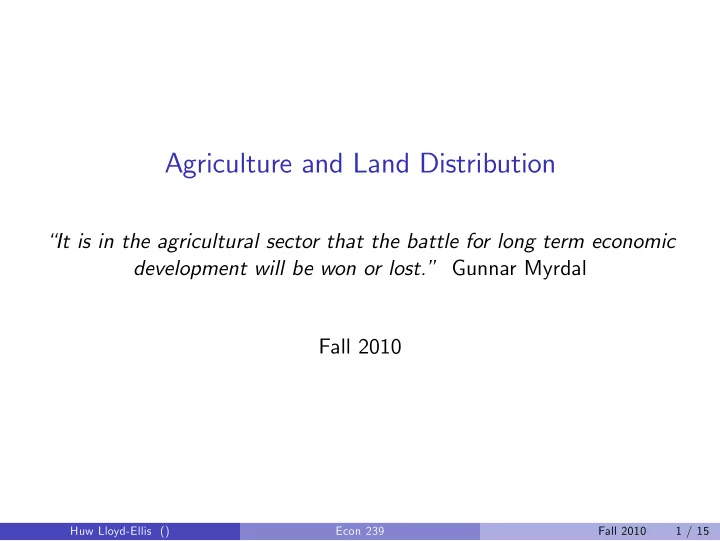

Agriculture and Land Distribution “It is in the agricultural sector that the battle for long term economic development will be won or lost.” Gunnar Myrdal Fall 2010 Huw Lloyd-Ellis () Econ 239 Fall 2010 1 / 15
Agriculture in developing countries – A brief overview A large fraction of developing country populations work in agriculture and even more are dependent on it Traditional view of agriculture: passive role in development , ! source of surplus labour for industry , ! policy focus on industrialization and manufacturing exports , ! systematic bias against rural areas , ! more recent emphasis on Rural Development Di¤erent “mode” of production than developed nations ) more complex than just technology transfer Huw Lloyd-Ellis () Econ 239 Fall 2010 2 / 15
Huw Lloyd-Ellis () Econ 239 Fall 2010 3 / 15
Huw Lloyd-Ellis () Econ 239 Fall 2010 4 / 15
Indices of agricultural production per person (FAO) Extremely rapid growth in Asia (esp. due to China) Signi…cant but less rapid growth in Latin Ameria and North Africa Decline followed by stagnation in Sub–Saharan Africa Collapse in transition economies after 1990 Huw Lloyd-Ellis () Econ 239 Fall 2010 5 / 15
Huw Lloyd-Ellis () Econ 239 Fall 2010 6 / 15
Huw Lloyd-Ellis () Econ 239 Fall 2010 7 / 15
Latin America High concentration of land – 2% of landowners own 72% of land Traditional latifundio–minifundio system: Latifundio > 12 employees Medium–sized 4 – 12 Family farm 2 – 4 Minifundio < 2 Smaller farms often have higher output per hectare than large farms , ! underutilization of land ? , ! high supervision/motivation costs on larger farms ? , ! sharecropping Recent expansion of modern inputs in some regions ) large productivity gains (e.g. Brazil) Huw Lloyd-Ellis () Econ 239 Fall 2010 8 / 15
Land inequality by region (2004) Region Mean Land Gini # of countries South America 79.9 11 Central America 72.3 7 Caribbean 68.1 7 East Asia 38.4 4 South Asia 53.7 6 South East Asia 47.9 8 North Africa & Middle East 65.1 12 South & East Sub-Saharan Africa 62.7 12 West and Central Sub-Saharan Africa 45.2 14 Western O¤shoots 61.9 4 Western Europe 63.9 14 Eastern Europe 51.0 4 Scandanavia 49.3 8 World 59.7 111 Huw Lloyd-Ellis () Econ 239 Fall 2010 9 / 15
Asia “Too many people on too little land” Early introduction of private property rights due to colonialization , ! absentee landlords and sharecroppers/tenants. Rapid population growth , ! fragmentation of land China , ! major increase in productivity following 1978 land reforms , ! collective ownership vs. the household responsibility system Huw Lloyd-Ellis () Econ 239 Fall 2010 10 / 15
Huw Lloyd-Ellis () Econ 239 Fall 2010 11 / 15
Huw Lloyd-Ellis () Econ 239 Fall 2010 12 / 15
Africa Still mainly subsistence farming , ! exceptions in some former colonial settlements Traditional methods/institutions still dominate , ! some shifting cultivation , ! traditional technologies , ! seasonal employment , ! communal land rights Rapid population growth and increasing commercialization , ! increasing pressure on traditional methods (esp. in Kenya, Nigeria, Ghana, Uganda) , ! soil erosion and deforestation of marginal lands ) need new methods Huw Lloyd-Ellis () Econ 239 Fall 2010 13 / 15
Evolution of the Mode of Agricultural Production Subsistence farming — risk and uncertainty , ! reluctance to adopt new technologies , ! ine¢cient contractual arrangements (e.g. sharecropping) Mixed and diversi…ed farming — cash crops , ! commercialization due to urban growth and trade , ! supportive institutional framework is crucial Modern commercial farming Huw Lloyd-Ellis () Econ 239 Fall 2010 14 / 15
Rural Development Policy (since 1980s) Policies to accelerate technology adoption and innovation , ! scale neutrality (e.g. green revolution) Policies to improve institutional structure , ! increased access to credit, research, irrigation services, etc. , ! crop insurance Improved agricultural pricing policies Land reform Extension of public services to rural areas Huw Lloyd-Ellis () Econ 239 Fall 2010 15 / 15
Recommend
More recommend